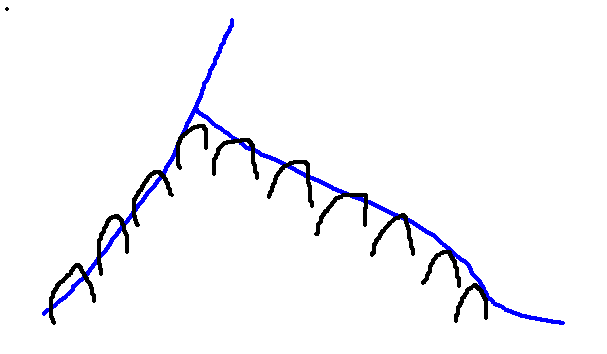RQNOJ 601(区间覆盖问题)
查看题目 Show Problem
题目:[NOIP2010]引水入城
问题编号:601
题目描述

在一个遥远的国度,一侧是风景秀美的湖泊,另一侧则是漫无边际的沙漠。该国的行政区划十分特殊,刚好构成一个N 行M 列的矩形,如上图所示,其中每个格子都代表一座城市,每座城市都有一个海拔高度。
为了使居民们都尽可能饮用到清澈的湖水,现在要在某些城市建造水利设施。水利设施有两种,分别为蓄水厂和输水站。蓄水厂的功能是利用水泵将湖泊中的水抽取到所在城市的蓄水池中。因此,只有与湖泊毗邻的第1 行的城市可以建造蓄水厂。而输水站的功能则是通过输水管线利用高度落差,将湖水从高处向低处输送。故一座城市能建造输水站的前提,是存在比它海拔更高且拥有公共边的相邻城市,已经建有水利设施。
由于第N 行的城市靠近沙漠,是该国的干旱区,所以要求其中的每座城市都建有水利设施。那么,这个要求能否满足呢?如果能,请计算最少建造几个蓄水厂;如果不能,求干旱区中不可能建有水利设施的城市数目。
【样例1 说明】
只需要在海拔为9 的那座城市中建造蓄水厂,即可满足要求。
【样例2 说明】

上图中,在3 个粗线框出的城市中建造蓄水厂,可以满足要求。以这3 个蓄水厂为源头
在干旱区中建造的输水站分别用3 种颜色标出。当然,建造方法可能不唯一。
【数据范围】
输入格式
输入文件的每行中两个数之间用一个空格隔开。
输入的第一行是两个正整数N 和M,表示矩形的规模。
接下来N 行,每行M 个正整数,依次代表每座城市的海拔高度。
输出格式
输出有两行。如果能满足要求,输出的第一行是整数1,第二行是一个整数,代表最少
建造几个蓄水厂;如果不能满足要求,输出的第一行是整数0,第二行是一个整数,代表有
几座干旱区中的城市不可能建有水利设施。
样例输入
【输入输出样例1】2 5
9 1 5 4 3
8 7 6 1 2
【输入输出样例2】
3 6
8 4 5 6 4 4
7 3 4 3 3 3
3 2 2 1 1 2
样例输出
【输入输出样例1】
1
1
【输入输出样例2】
1
3
先floodfill,判定有无解。
若有解,则没个蓄水站必然会覆盖的区间一定连续
下面这幅图说明了这一点:
显然水无论如何也无法流进中间的区间,证毕。
注:下文使用的区间覆盖假定一定有解,若无解则需另加考虑。
Another PS:http://lhz1208.diandian.com/post/2011-11-11/6674864
Program desert;
const
maxn=501;
maxm=501;
INF=2139062143;
var
n,m,i,j,tot,nowl,maxr:longint;
height:array[0..maxn,0..maxm] of longint;
l,r:array[1..maxm] of longint;
b:array[0..maxn,0..maxm] of boolean;
Procedure swap(var a,b:longint);
var
p:longint;
begin
p:=a;a:=b;b:=p;
end;
function max(a,b:longint):longint;
begin
if a<b then exit(b) else exit(a);
end;
Procedure floodfill(x,y:longint);
var
i,j:longint;
begin
b[x,y]:=true;
if not(b[x+1,y]) and (height[x+1,y]<height[x,y]) then floodfill(x+1,y);
if not(b[x-1,y]) and (height[x-1,y]<height[x,y]) then floodfill(x-1,y);
if not(b[x,y+1]) and (height[x,y+1]<height[x,y]) then floodfill(x,y+1);
if not(b[x,y-1]) and (height[x,y-1]<height[x,y]) then floodfill(x,y-1);
end;
Procedure qsort(_l,_r:longint);
var
i,j,m,p:longint;
begin
i:=_l;
j:=_r;
m:=l[(i+j) div 2];
repeat
while (l[i]<m) do inc(i);
while (l[j]>m) do dec(j);
if i<=j then
begin
swap(l[i],l[j]);
swap(r[i],r[j]);
inc(i); dec(j);
end;
until i>j;
if (_l<j) then qsort(_l,j);
if (i<_r) then qsort(i,_r);
end;
begin
read(n,m);
fillchar(b,sizeof(b),false);
fillchar(height,sizeof(height),127);
for i:=1 to n do
for j:=1 to m do
read(height[i,j]);
tot:=0;
for i:=1 to m do floodfill(1,i);
for i:=1 to m do if not(b[n,i]) then inc(tot);
if tot>0 then
begin
writeln('0');
writeln(tot);
halt;
end;
for i:=1 to m do
begin
fillchar(b,sizeof(b),false);
floodfill(1,i);
l[i]:=1;
r[i]:=m;
while not(b[n,l[i]]) and (l[i]<m) do inc(l[i]);
while not(b[n,r[i]]) and (r[i]>1) do dec(r[i]);
if not(b[n,l[i]]) then begin l[i]:=0; r[i]:=0; end;
end;
qsort(1,m);
nowl:=1; tot:=0; maxr:=0;
for i:=1 to m do
begin
if (l[i]<=nowl) then maxr:=max(maxr,r[i])
else
begin
inc(tot);
nowl:=maxr+1;
maxr:=r[i];
end;
end;
if nowl<m+1 then inc(tot);
writeln('1');
writeln(tot);
end.
